Sylvan Crafts – 12-Sided Die / Polyhedron Assembly
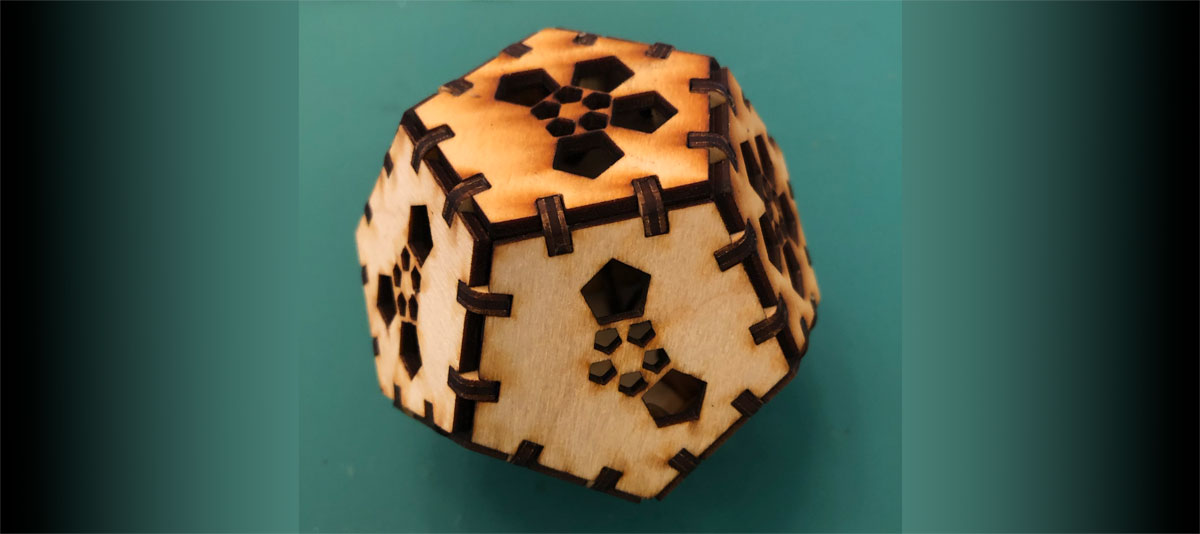
Things to consider before you assemble your Sylvan Crafts kit:
This model was laser cut from natural wood so will have burn marks and scorching. The burns and scorching actually add to the appeal and aesthetics of the wood, so we recommend you assemble your kit with the scorched side of each piece facing outward, for optimal attractiveness.
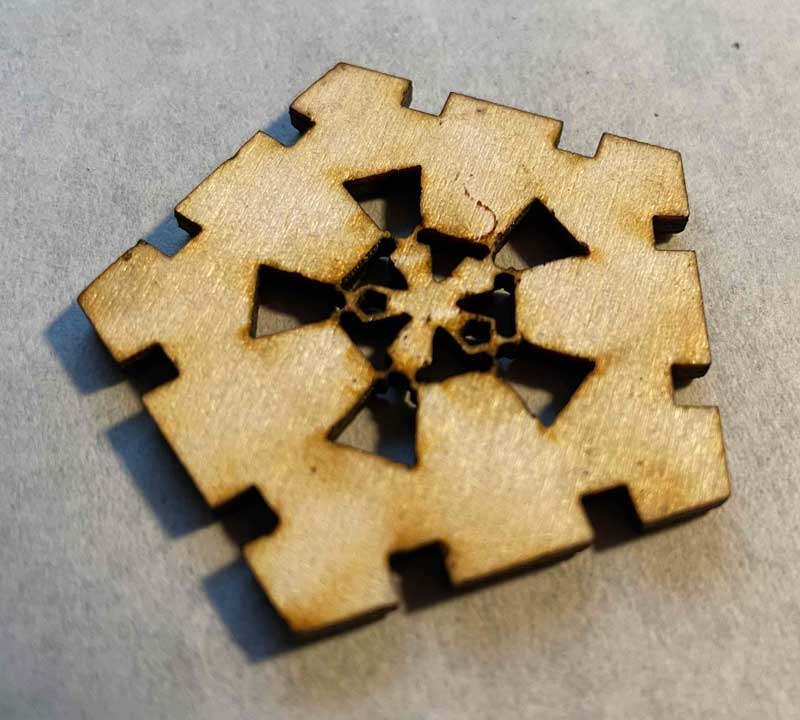
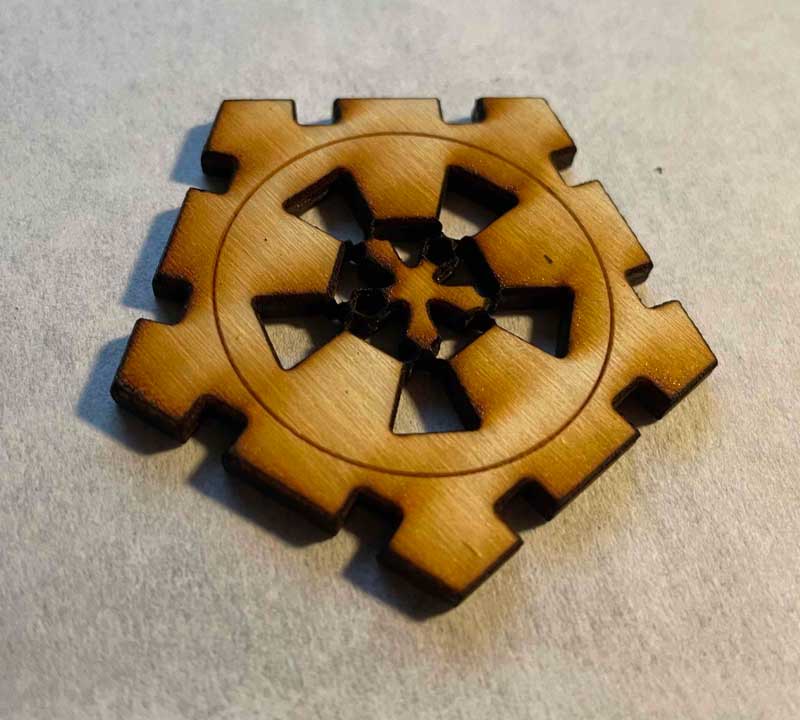
We recommend completing assembly in one sitting; although it is certainly possible to assemble the kit in multiple sessions. Assembling in one sitting allows for you to work while the glue is still a bit flexible, especially if something is slightly out of alignment. A typical first-timer assembly of a kit should take about an hour.
Handy Tip:
Take a quick scroll through all the instructions below to familiarize yourself with the project before starting.Equipment Required:
- A good quality wood glue, such as Titebond/Titebond II (available at any home store). Wood glue will stay flexible as you work with the pieces.
- A craft mat, or some other work surface (not your nana's good dining room table) where you don't have to worry about glue getting on anything. Kitchen parchment paper (used in baking) makes a wonderful work surface when taped flat with painters’ tape.
- A handful of wooden toothpicks for applying glue.
Prepare for Assembly:
There are two types of pieces in this kit:
12 polygon face pieces (5-sided)
60 mushroom-shaped joint pieces
Separate Face Pieces and Joint Pieces From the Board:
- Peel top adhesive layer back carefully – exposing all pieces of the kit. NOTE: Some of the cutouts for the pips (holes in the face pieces) and sprue (junk between joint pieces) may stick to the adhesive paper. This is okay, as long as none of the small joint pieces are accidentally discarded.
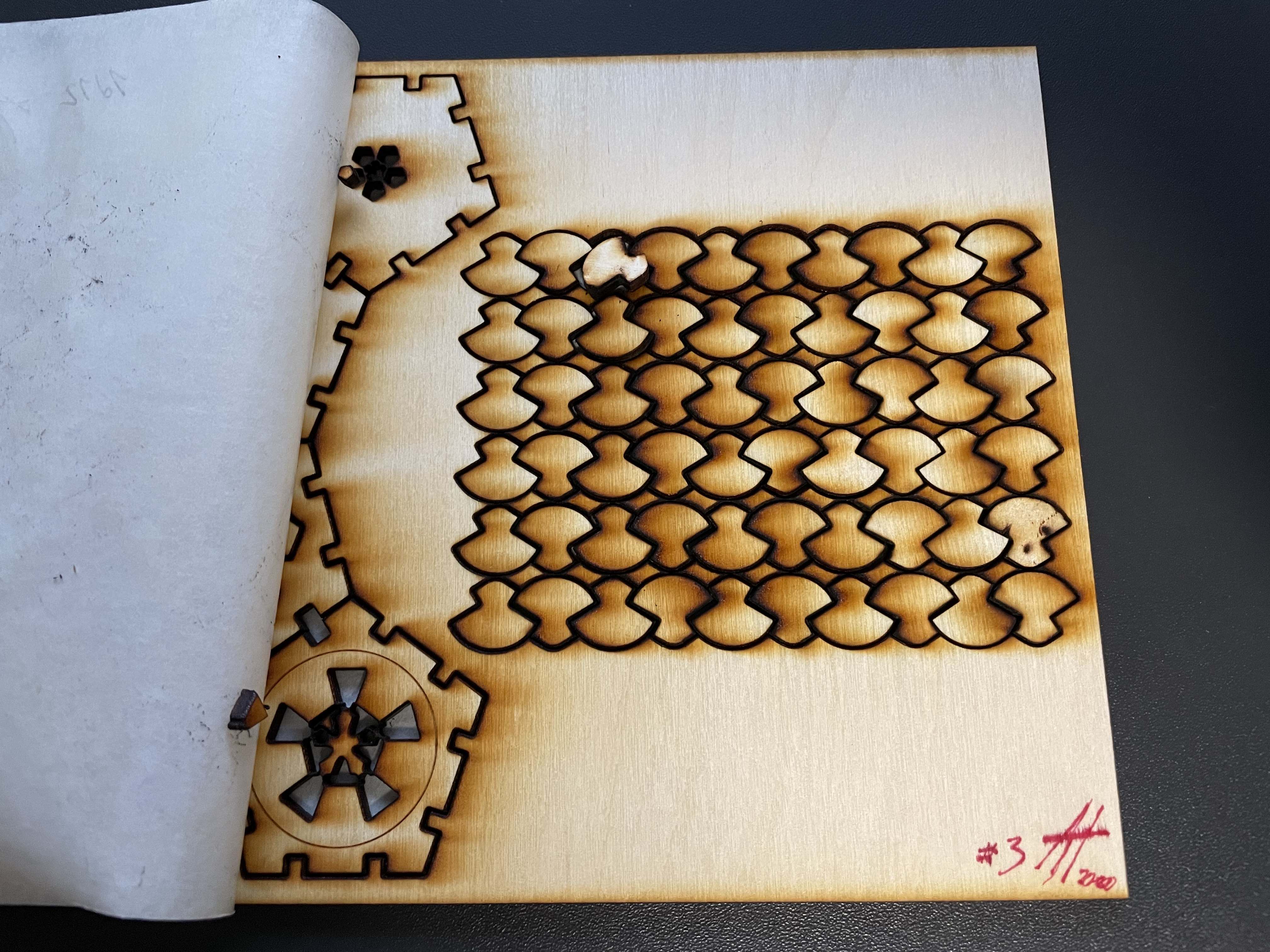
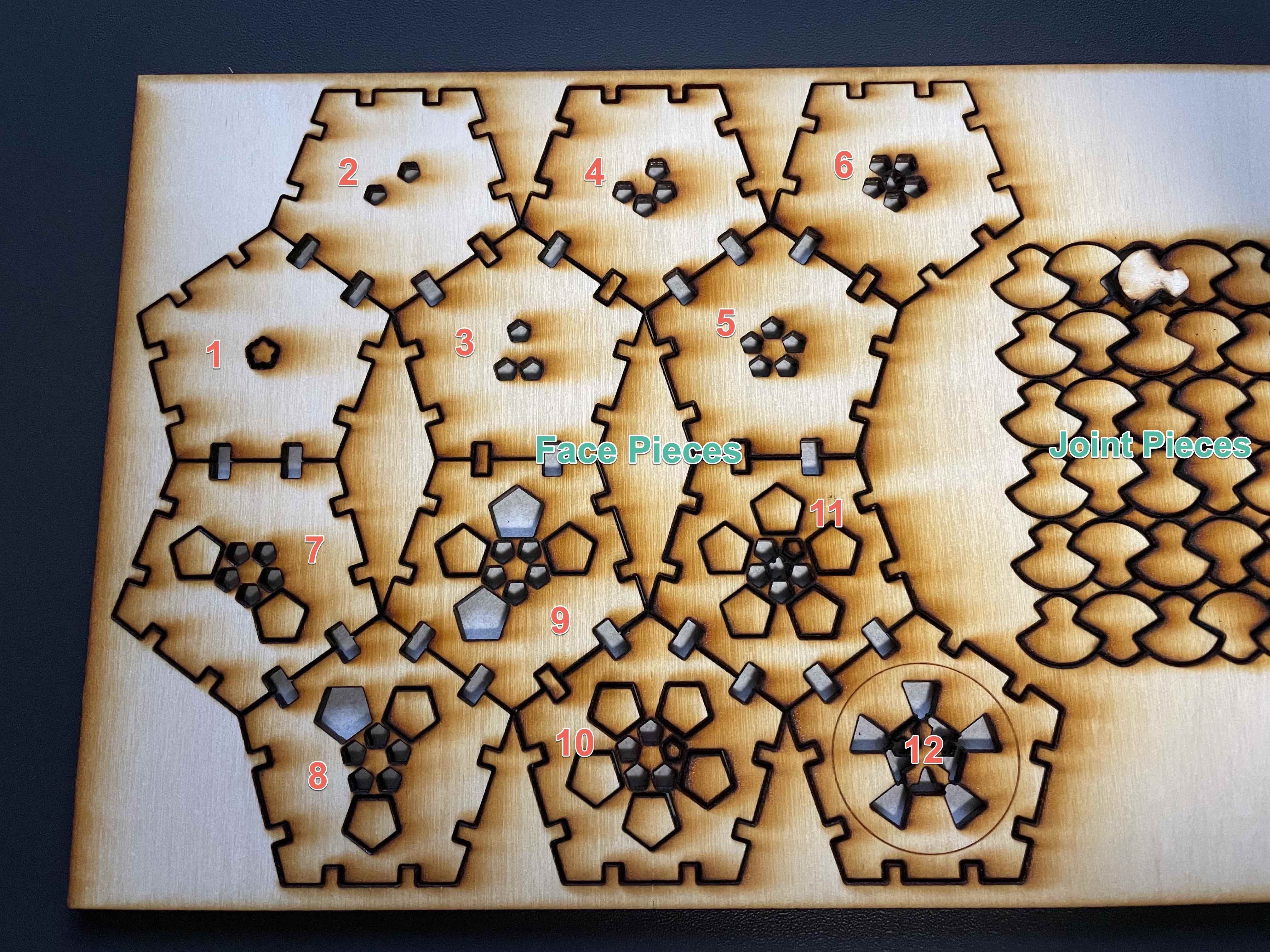
- Carefully remove all 60 joint pieces (the little mushroom looking guys) and place to the side – preferably in a little dish to keep them together.
- Carefully lift out the 12 polygonal face pieces. You may need to use a toothpick to pop out any cutouts left in the pips of the face pieces. Usually the cutouts will stay stuck to the bottom adhesive paper. Stack the face pieces nearby in numeric order. Once you are sure there are no joint pieces or face pieces left, you can discard the board in your green yard waste recycle bin (adhesive paper and all).
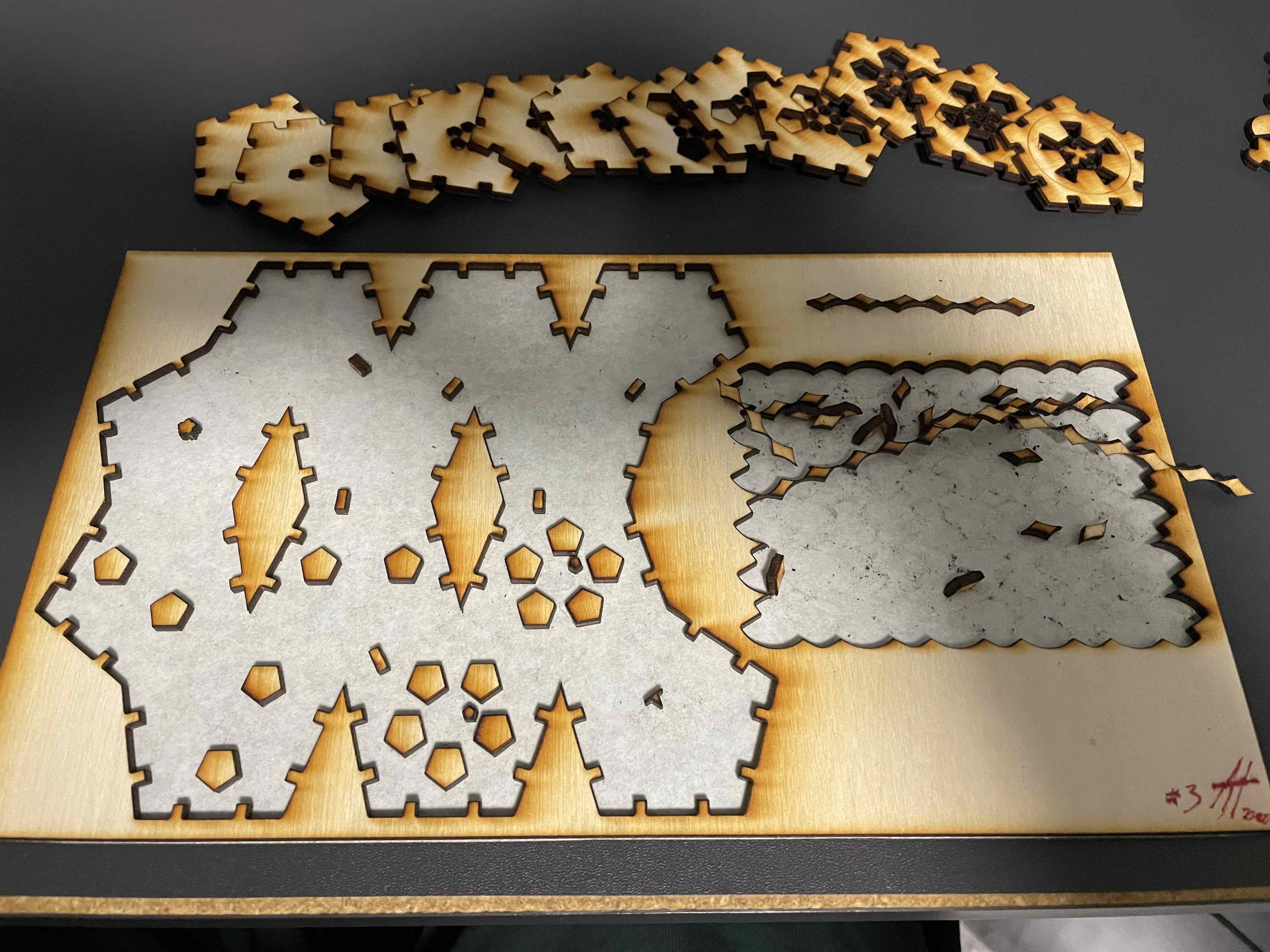
Assembly:
Put a blob of glue (about the size of a bean) on your work surface so you can easily dip your toothpick into it during assembly. Start a fresh glue puddle as needed.Important:
You will only be adding glue directly to the joint pieces; never to the face pieces themselves. The right way to glue a joint piece is to use a small amount of glue and with your toothpick, just cover the inner edges of one side of a joint piece. See the pink highlighted areas in the image below for where to apply glue.
Remember:
Keep the scorched/charred side on the outside of the assembled kit so you can enjoy the beautiful coloration of the wood.Prepping Your First Face Pieces:
- Starting with face piece #12. Flip it over so the pale side is facing up (non charred side) and the engraved circle is facedown. Glue 10 joint pieces to the #12 face piece as seen in image A below. As the glue begins to dry, snug the joint pieces again against the face piece to ensure they are seated tightly. Set aside.
- Select face pieces #2, #3, #7, #8, and #11. Starting with face piece #2, glue 6 joint pieces to any three adjacent edges, as seen in image B below. Repeat with each of these five face pieces.
- Next, we will be attaching the five pieces (#2, #3, #7, #8, and #11) you just prepared. Each face will be glued to the #12 face along one of its two edges. Each succeeding face will be glued in the same orientation – meaning the edge with no joint pieces for all face pieces will orient the same way: clockwise or counter-clockwise when viewed from above. This allows each succeeeding face piece to connect to the prior piece.
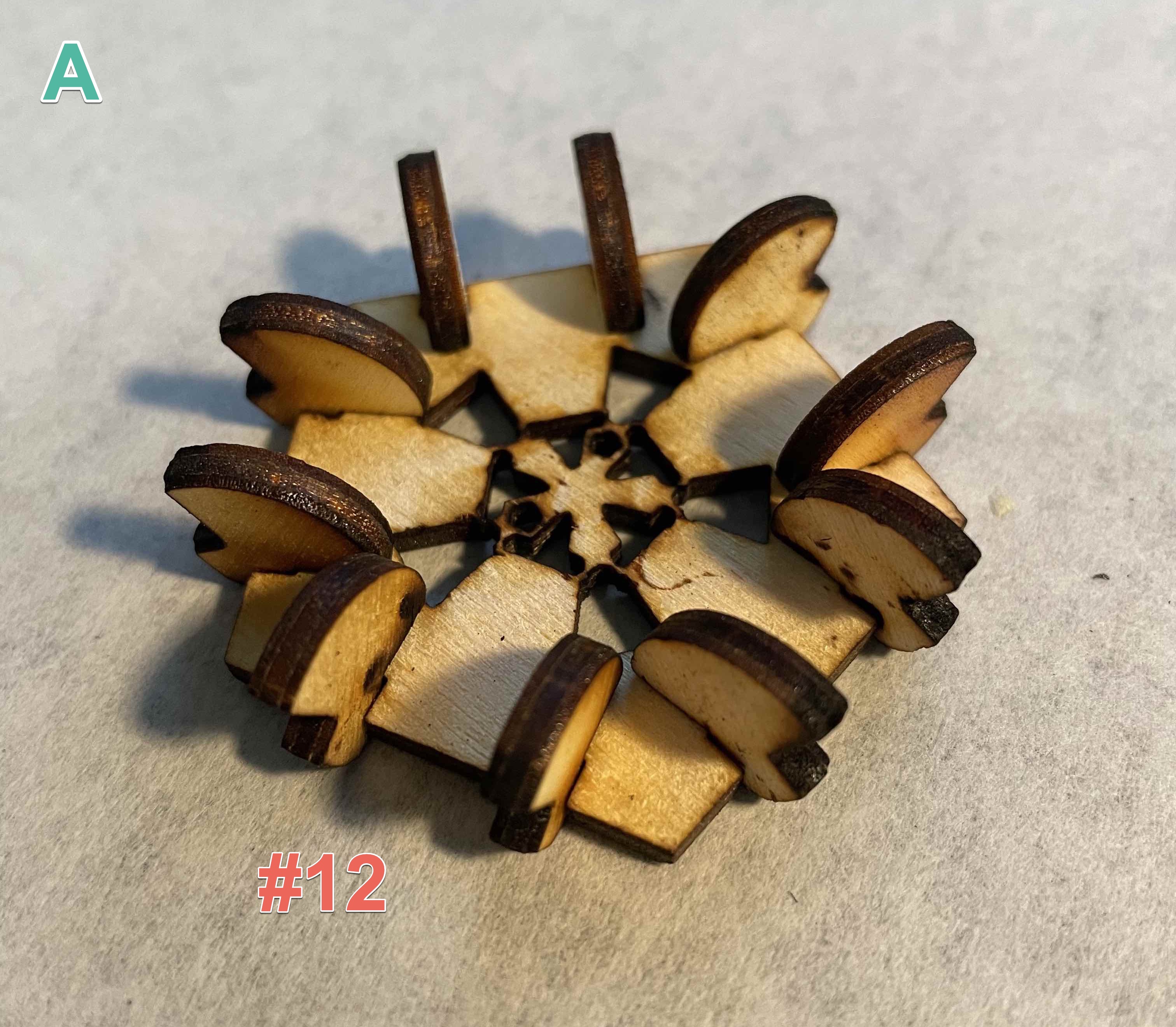
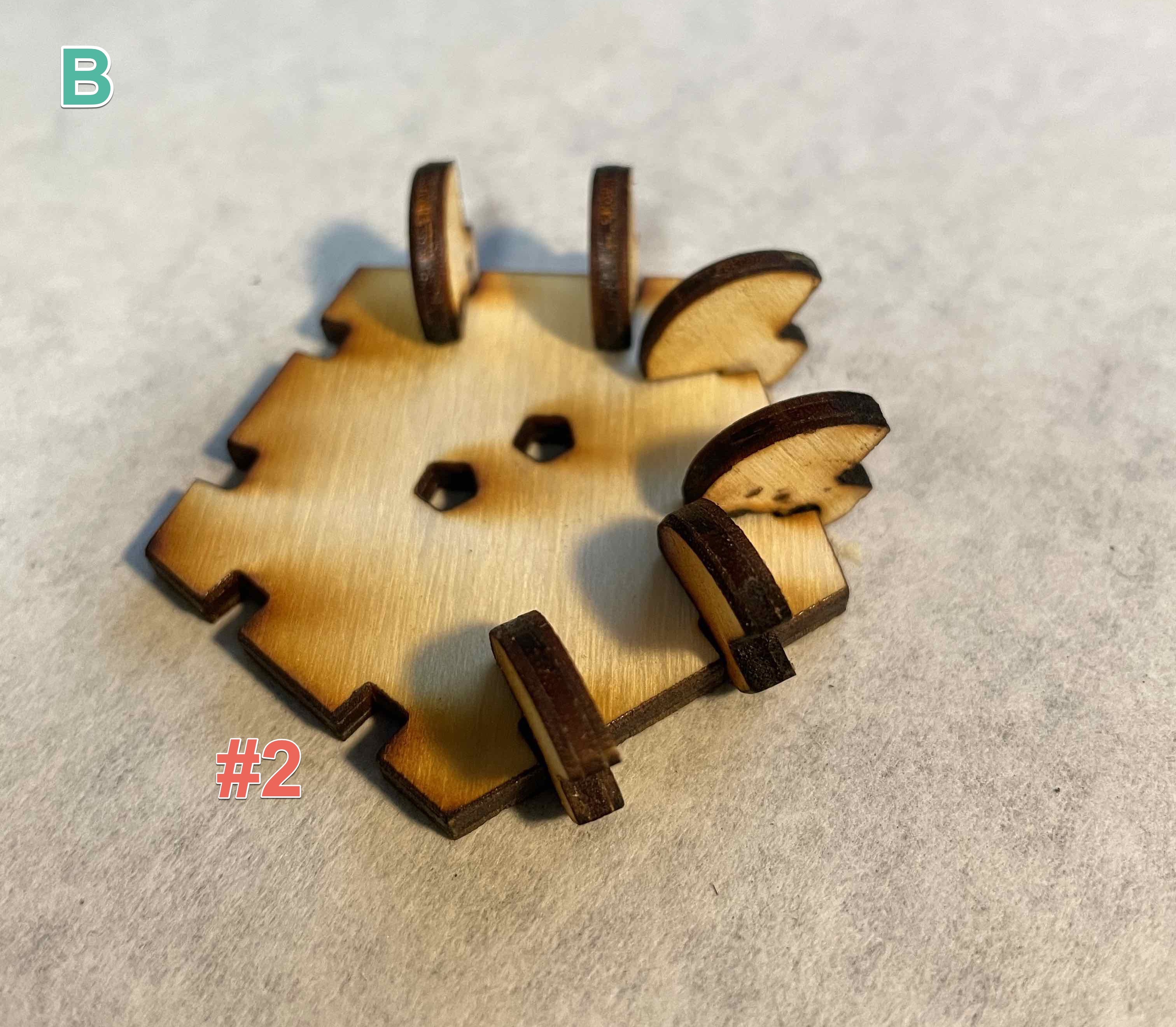
Handy Tip:
When gluing the five pieces (#2, #3, #7, #8, and #11) to face piece #12, we recommend working quickly with each piece so that when you come to the last piece, your glue is still tacky and you can slightly move the other pieces apart to squeeze the last piece in (it can be a tight fit).Assembling the First Six Face Pieces:
We will be attaching the five pieces (#2, #3, #7, #8, and #11) you prepared in the last step. Each face will be glued to the #12 face along one of its two un-jointed edges. Each succeeding face will be glued in the same orientation; meaning the edge with no joint pieces for all face pieces will orient the same way—clockwise or counter-clockwise—when viewed from above. This allows each succeeeding face piece to connect to the prior piece.
- Starting with face #2, apply glue to two joint pieces on any edge of the #12 piece. Connect piece #2 on one of its edges that has no joint pieces. Refer to image C below for an example. Remember to only apply glue to the joint pieces, and only where two face pieces are being joined together. The angle of the pieces on the inside is 108°. As long as you hold the face against the joint pieces firmly the face piece should hold its position at the right angle as you glue in the remaining face pieces.
Note how the pieces are being connected to each other in a clockwise order. If you happened to glue the first face piece to the #12 base with its blank edge facing counter-clockwise, that is totally fine, it just changes the position of the connector joints when glueing. Just make sure you continue will all other pieces in the correct order in either direction as denoted in the Face Orientation image below. - Continue with piece #3, as seen in image D below. Work your way around the base piece glueing pieces #2, #3, #11, #7 and finally the last piece #8. The final piece may require you to pry open the the other face pieces slightly in order to fit the last #8 face piece. The result will be a cup shape.
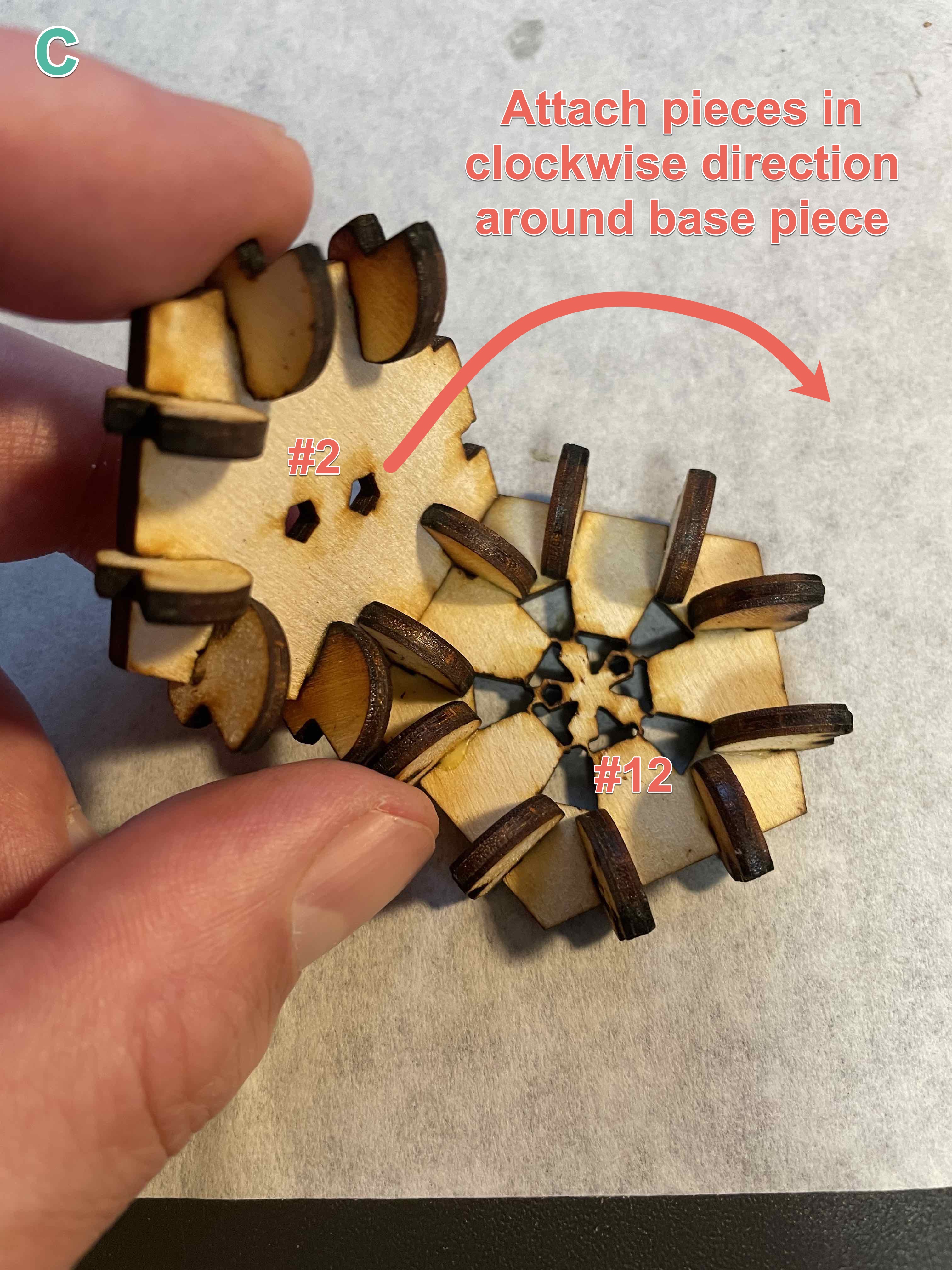
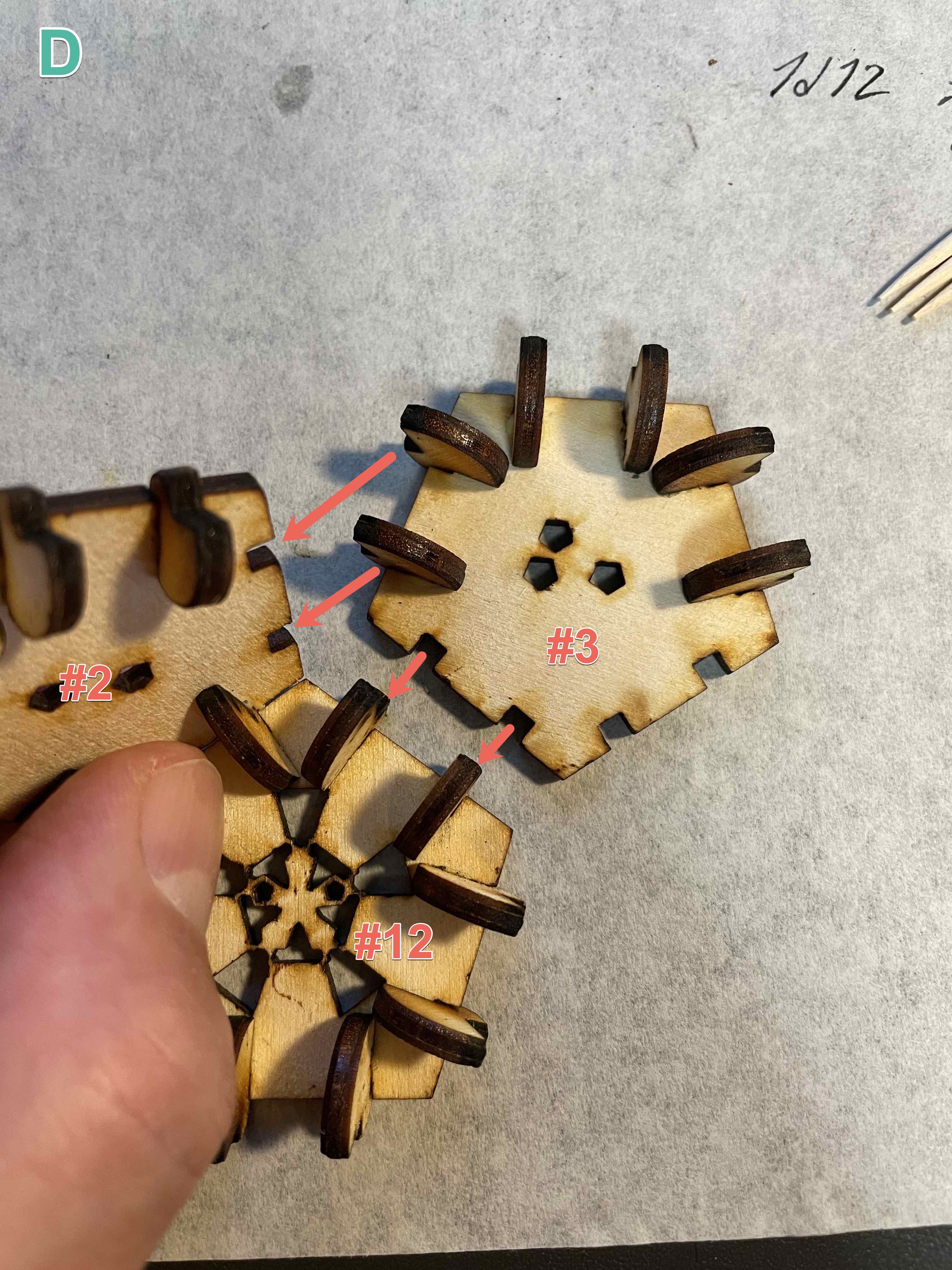
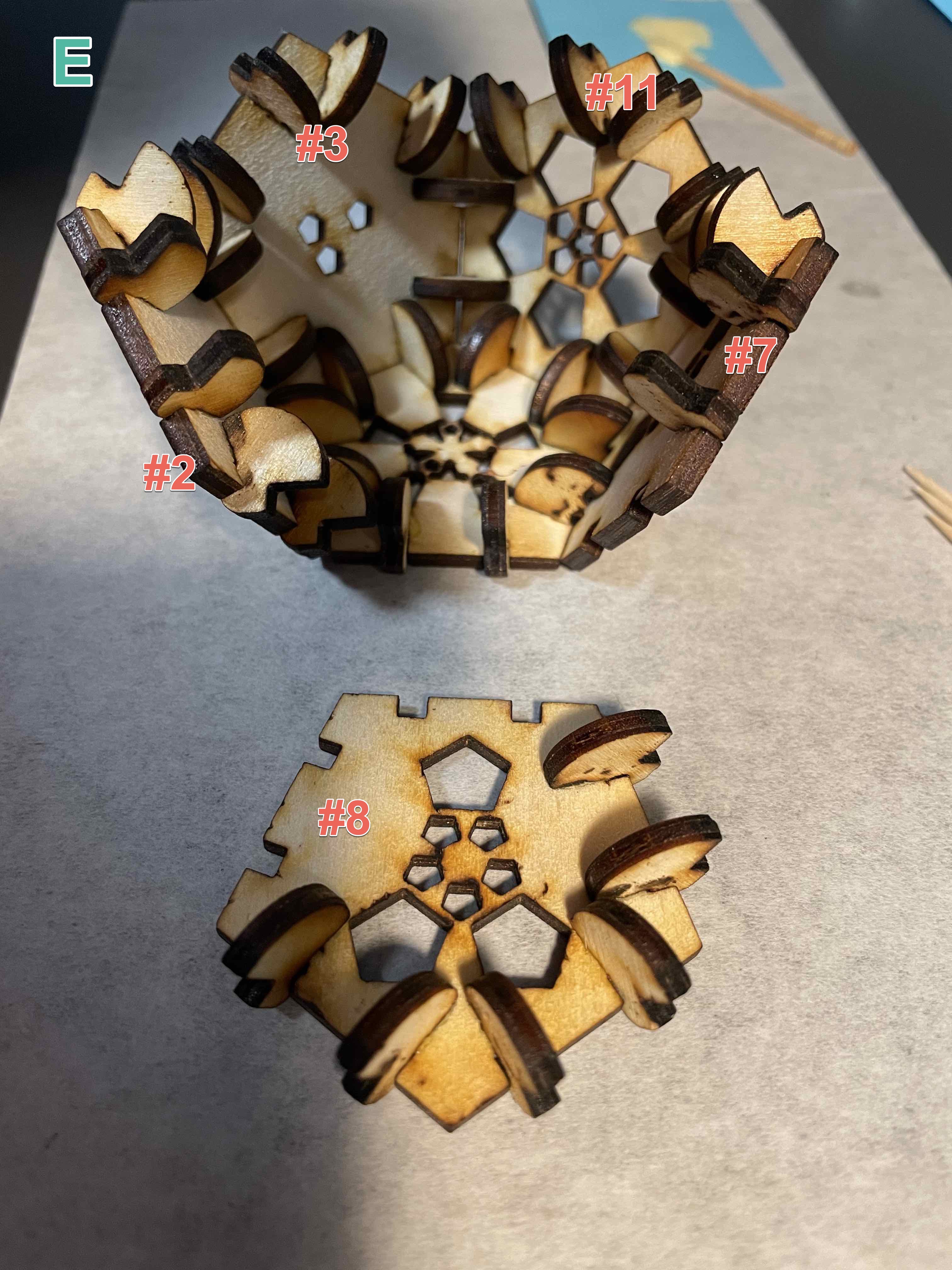
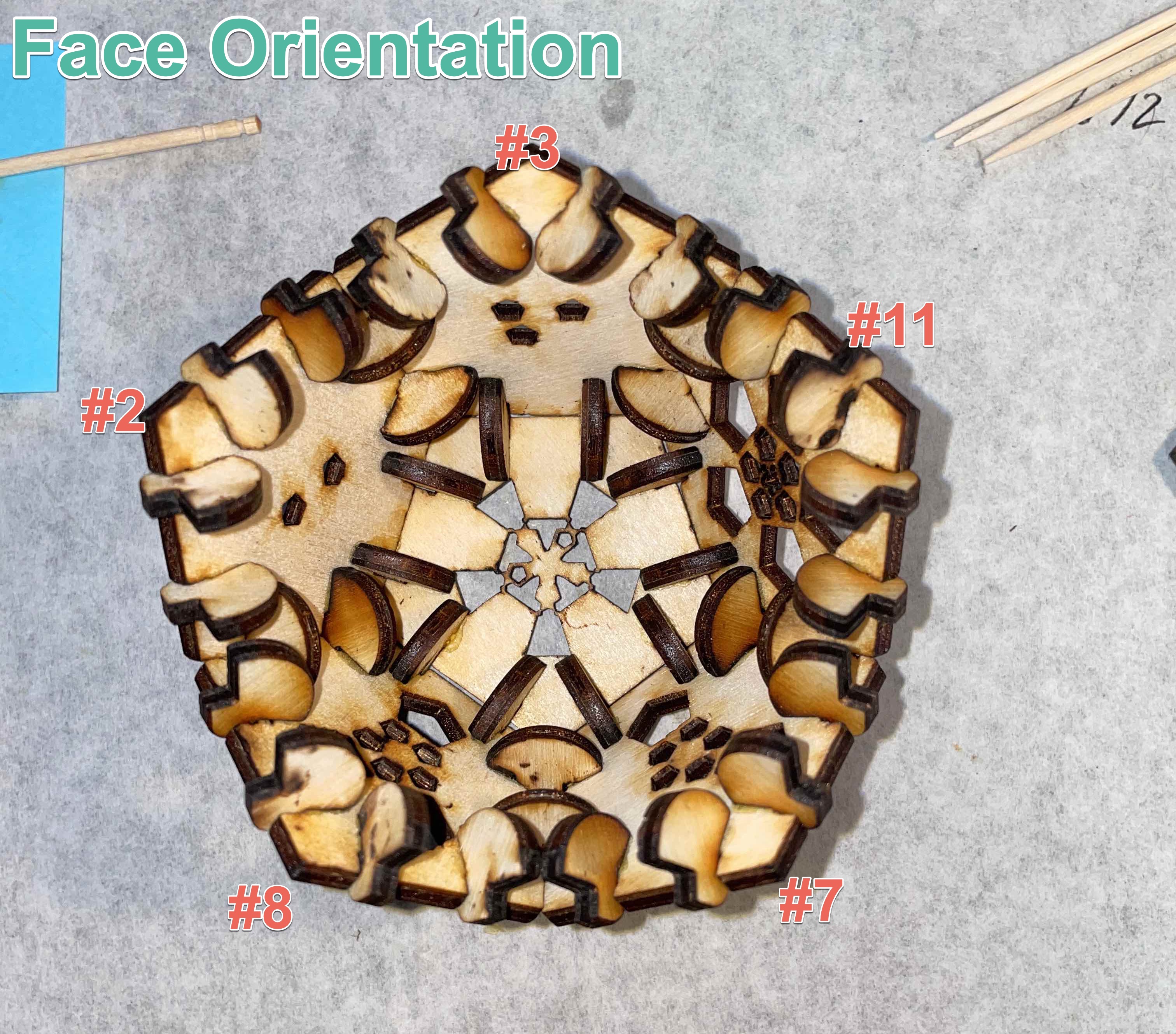
Interesting Fact:
Why is it important what order the faces are glued together? Since this model is a 12-sided die, there is a common layout of sides to assure when thrown, you get the most random value. This is desireable when using this die for gaming.- Once you've glued all five pieces together, hold the semi-completed polyhedron in your hand as seen in image F. Place your other hand over the top and using your bottom hand, cup the pieces together around the base #12 applying slight pressure with your hand on top. The goal here is to snug all pices together while the glue is still tacky to ensure a tight fit. Flip the polyhedron over and look at how the edges are joined (see image G). The edges should be very tight and close together, where little or no light can be seen between the edges. If you spot any larger gaps, use your hands to squeeze the pieces together so their edges have no gaps or very minimal gaps.
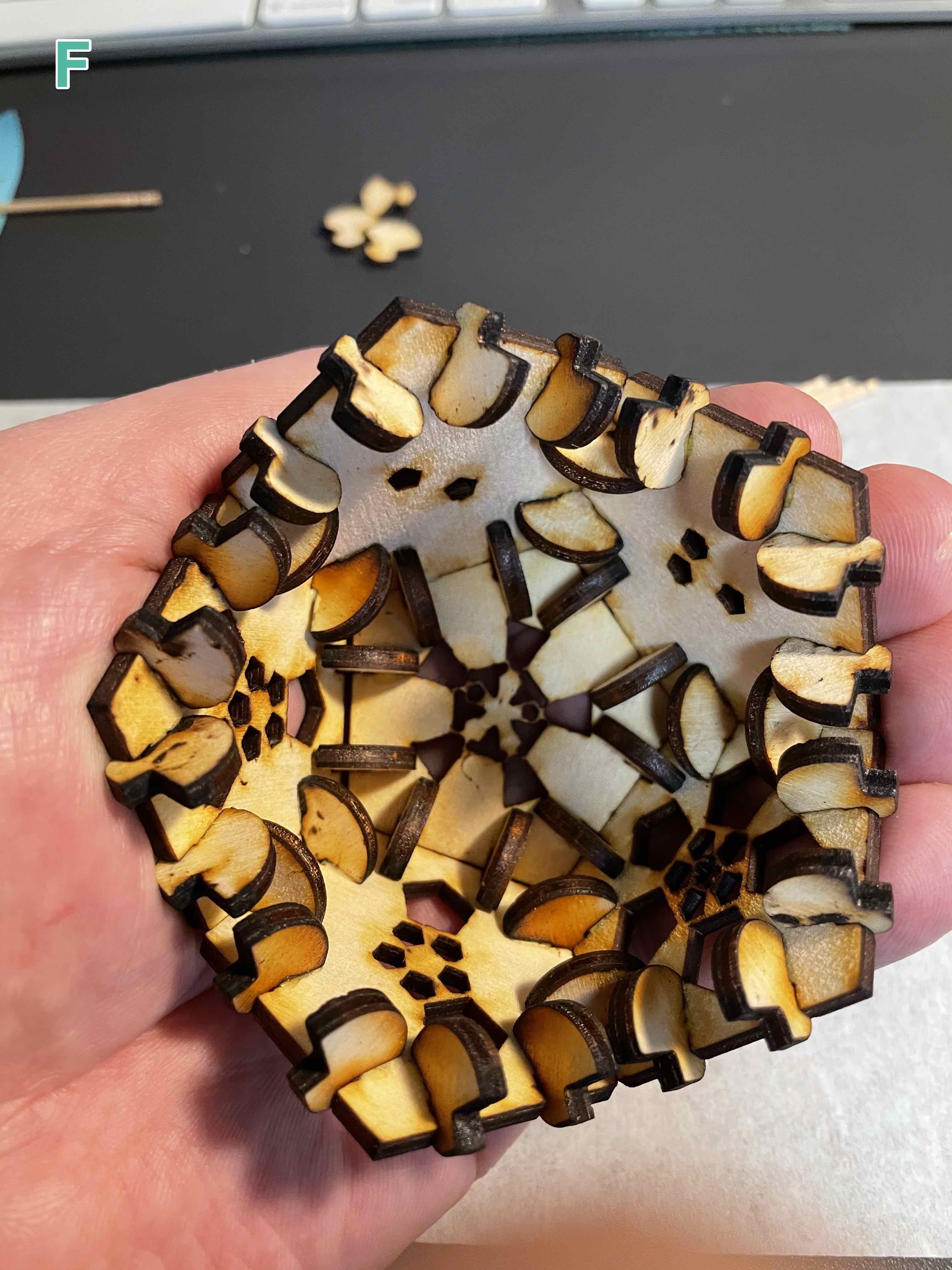
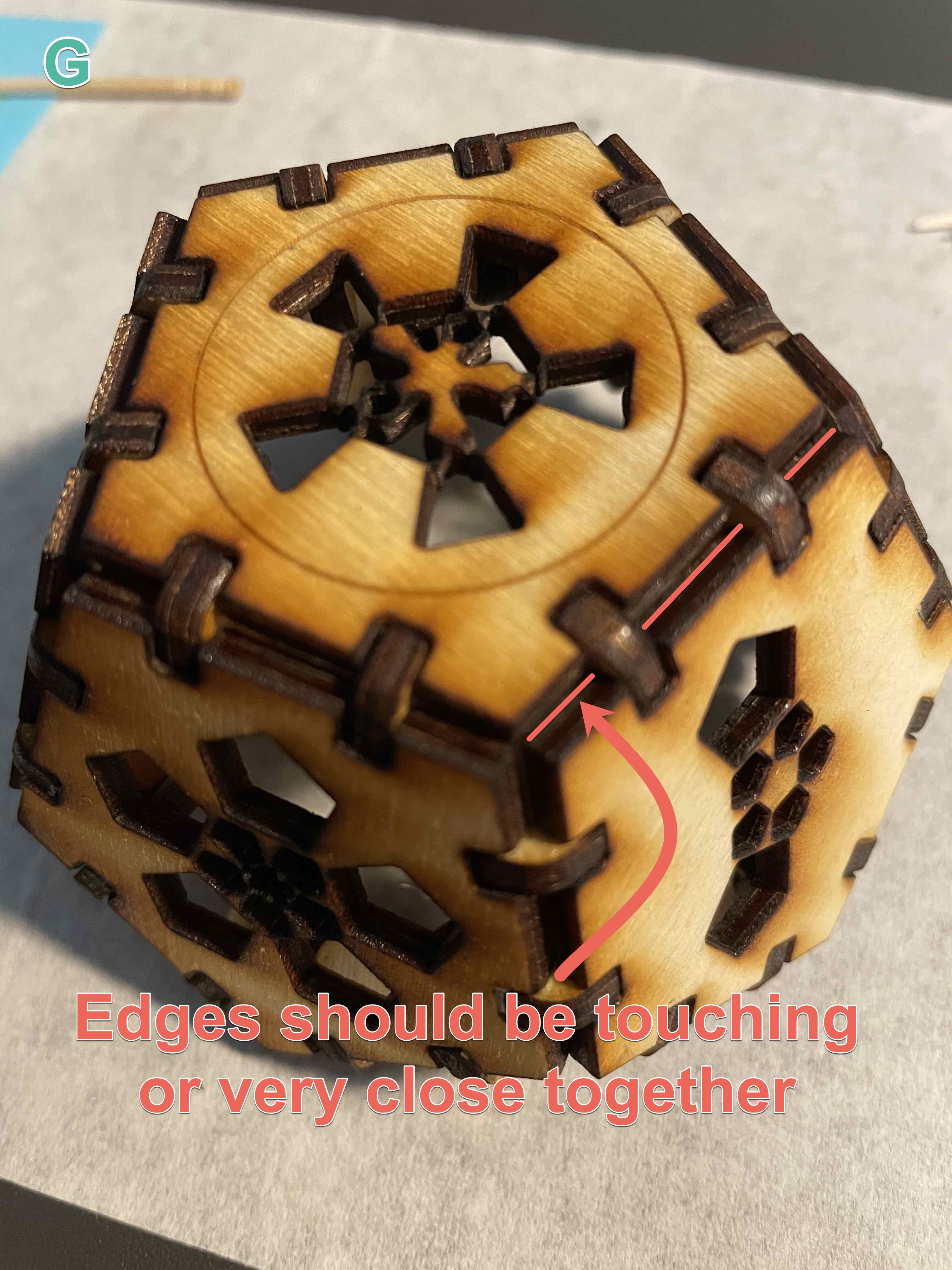
Prepping and Assembling the Other Face Pieces:
- Set face piece #5 aside. It's the final top piece and does not have any joint pieces attached to it.
- Select face pieces #1 and #10. Glue 6 joint pieces to any three adjacent edges, as seen in image B above to each of these face pieces.
- Tip the polyherdron onto face #7 and rotate so that faces #2 and #3 are in front of you. You will be glueing face #1 between these two pieces, as seen in image H below. Apply glue to the 4 joint pieces where pieces #2 and #3 meet. Snap piece #1 into the glued joints.
- Next, tip the polyherdron onto face #2 and rotate so that faces #7 and #11 are in front of you. You will be glueing face #10 between these two pieces, as seen in image I below. Apply glue to the 4 joint pieces where pieces #7 and #11 meet. Snap piece #10 into the glued joints so it looks like image J below.
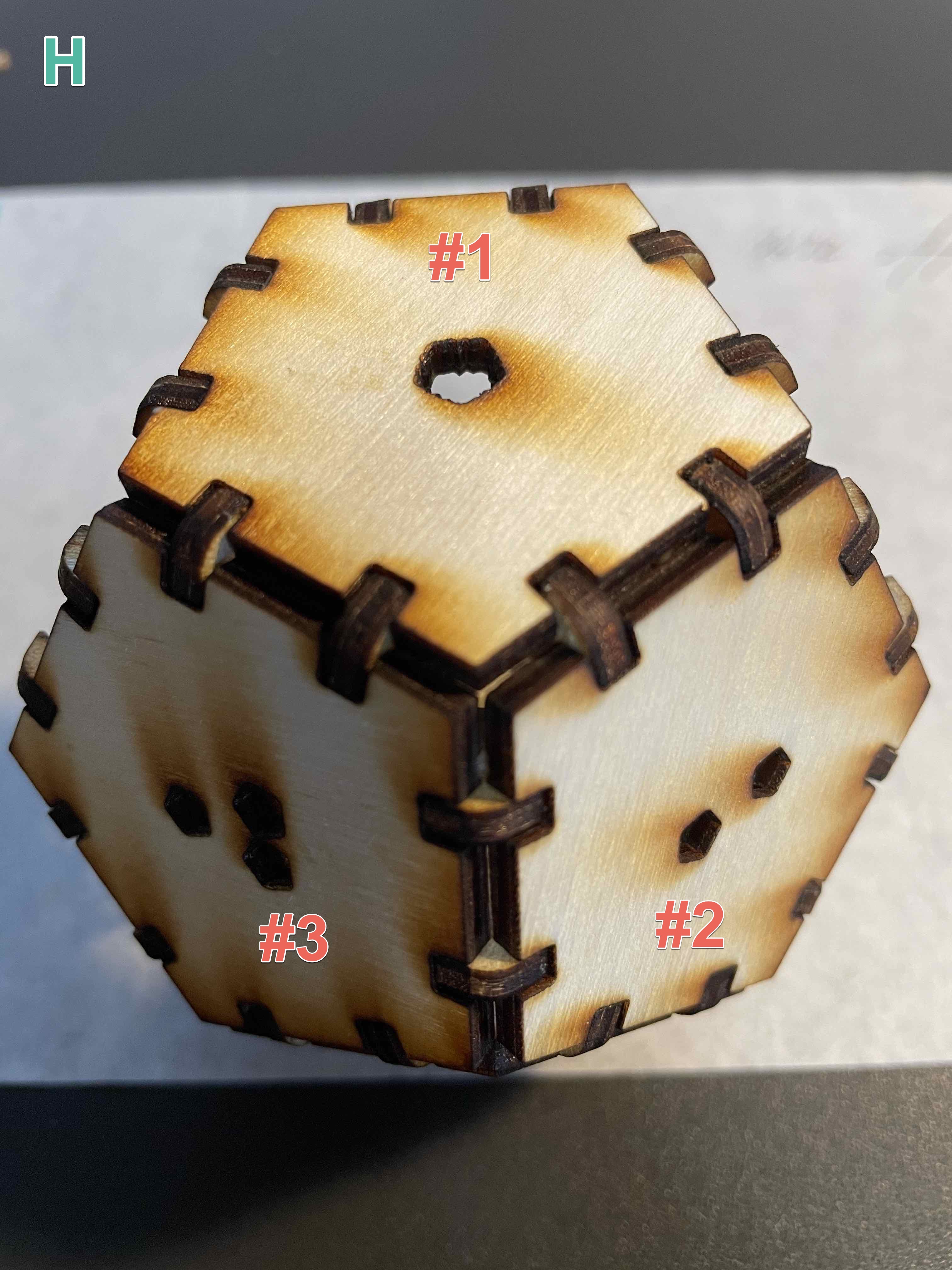
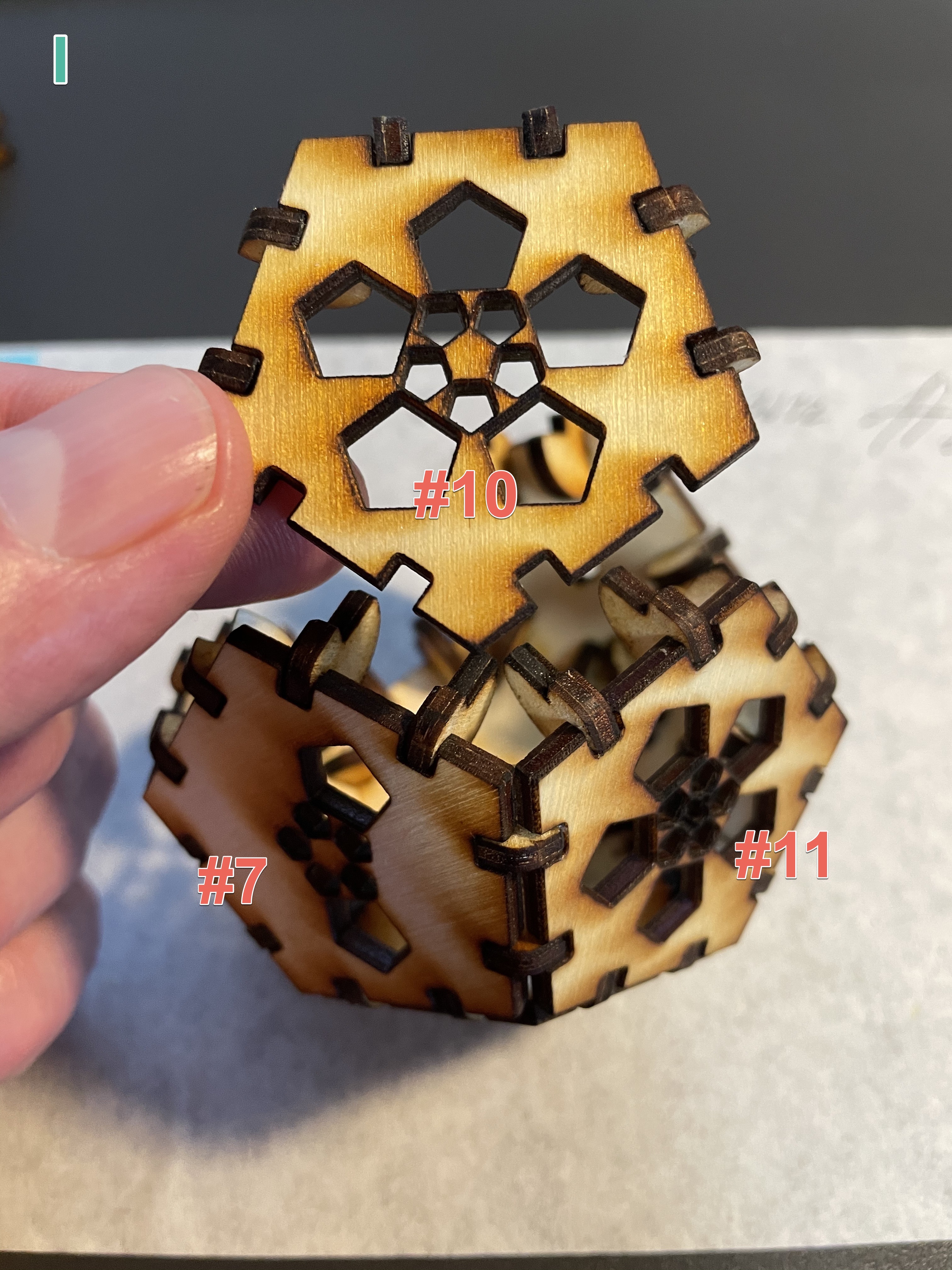
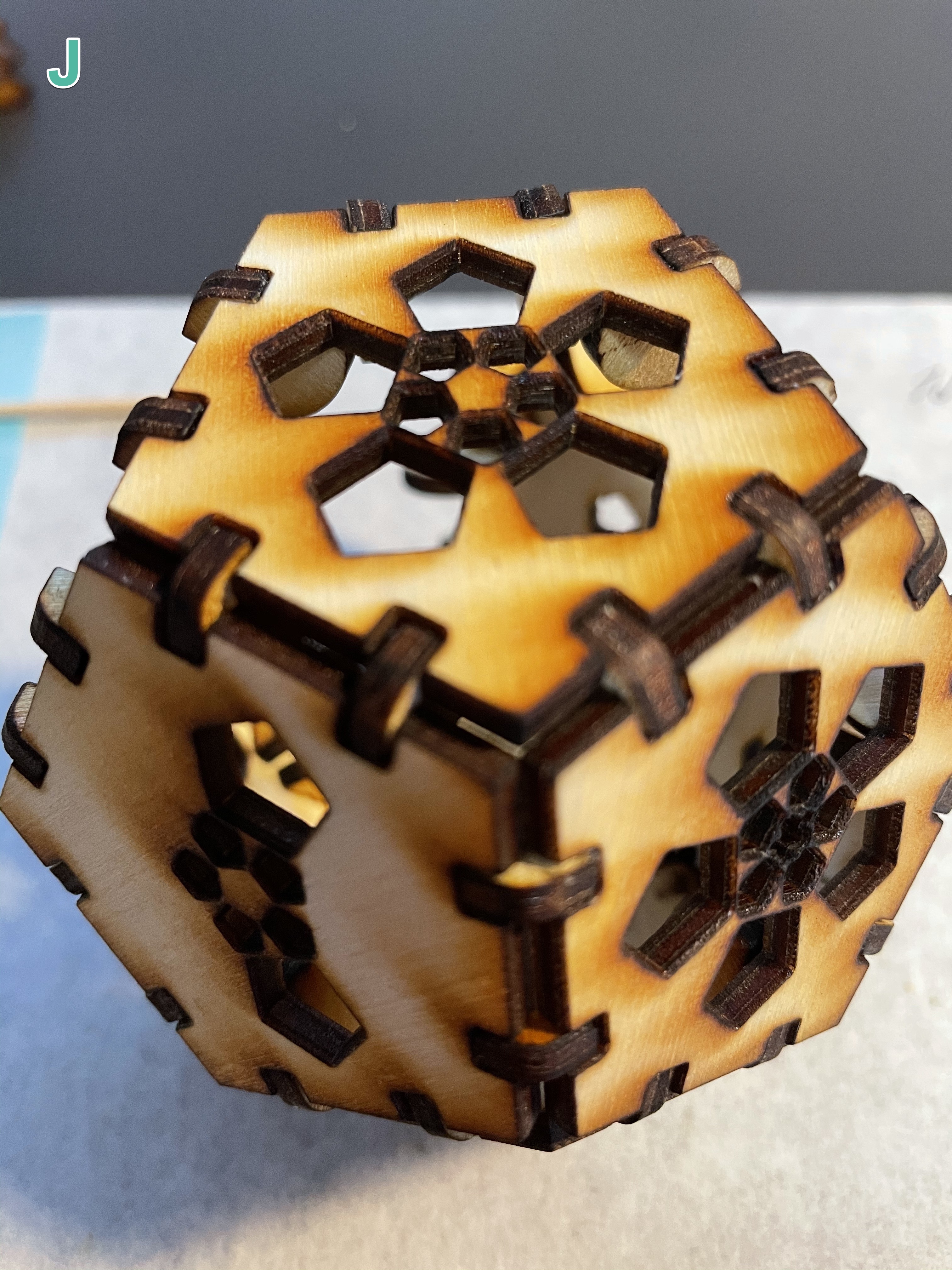
- Select face piece #6. Glue 4 joint pieces to any two adjacent edges as in image K below.
- Tip the polyherdron onto face #11 and rotate so that faces #1, #2 and #8 are in front of you. You will be glueing face #6 between these three pieces, as seen in image L below. Apply glue to the 6 joint pieces where pieces #1, #2 and #8 meet. Snap piece #6 into the glued joints so it looks like image M below.
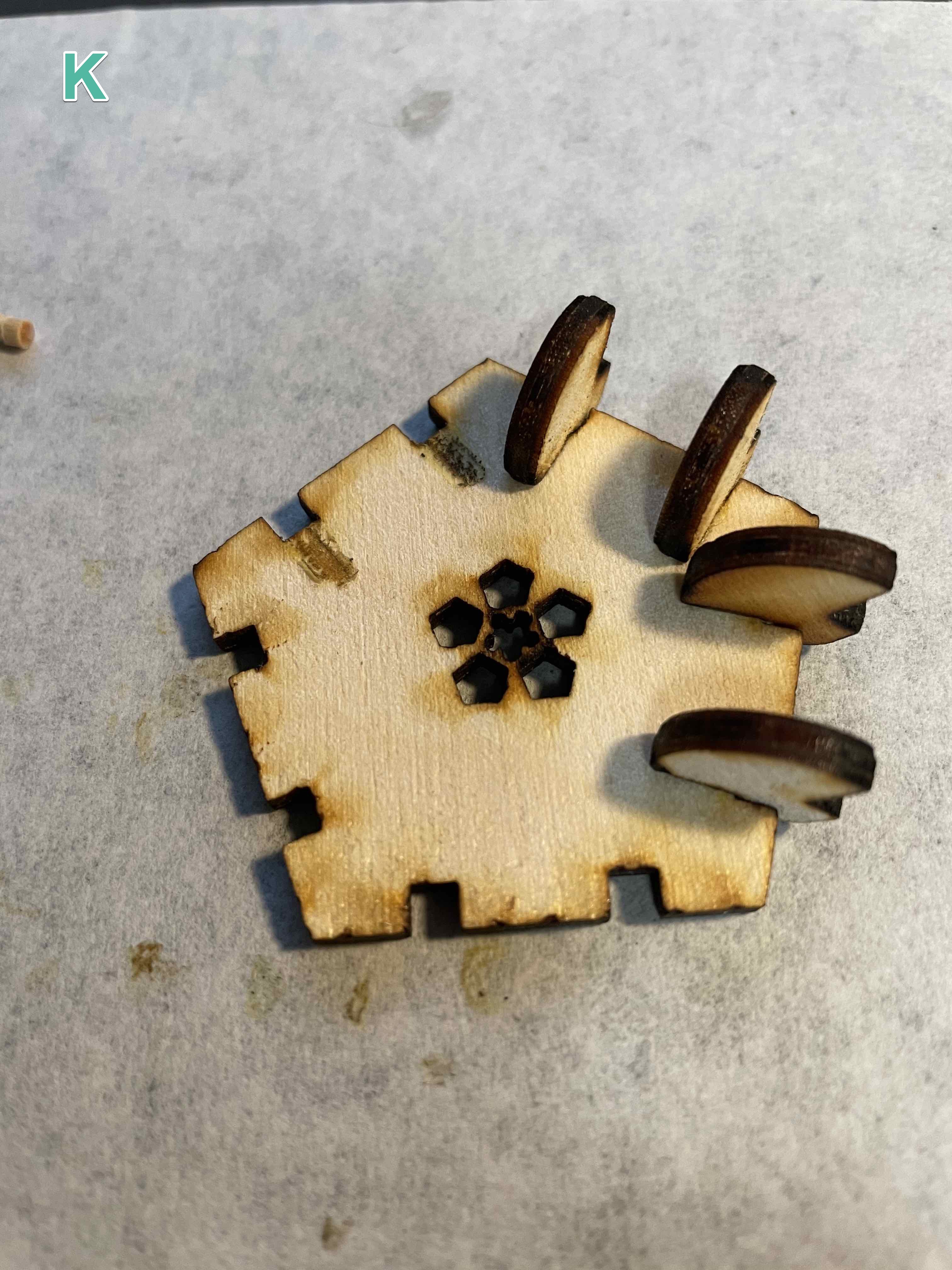
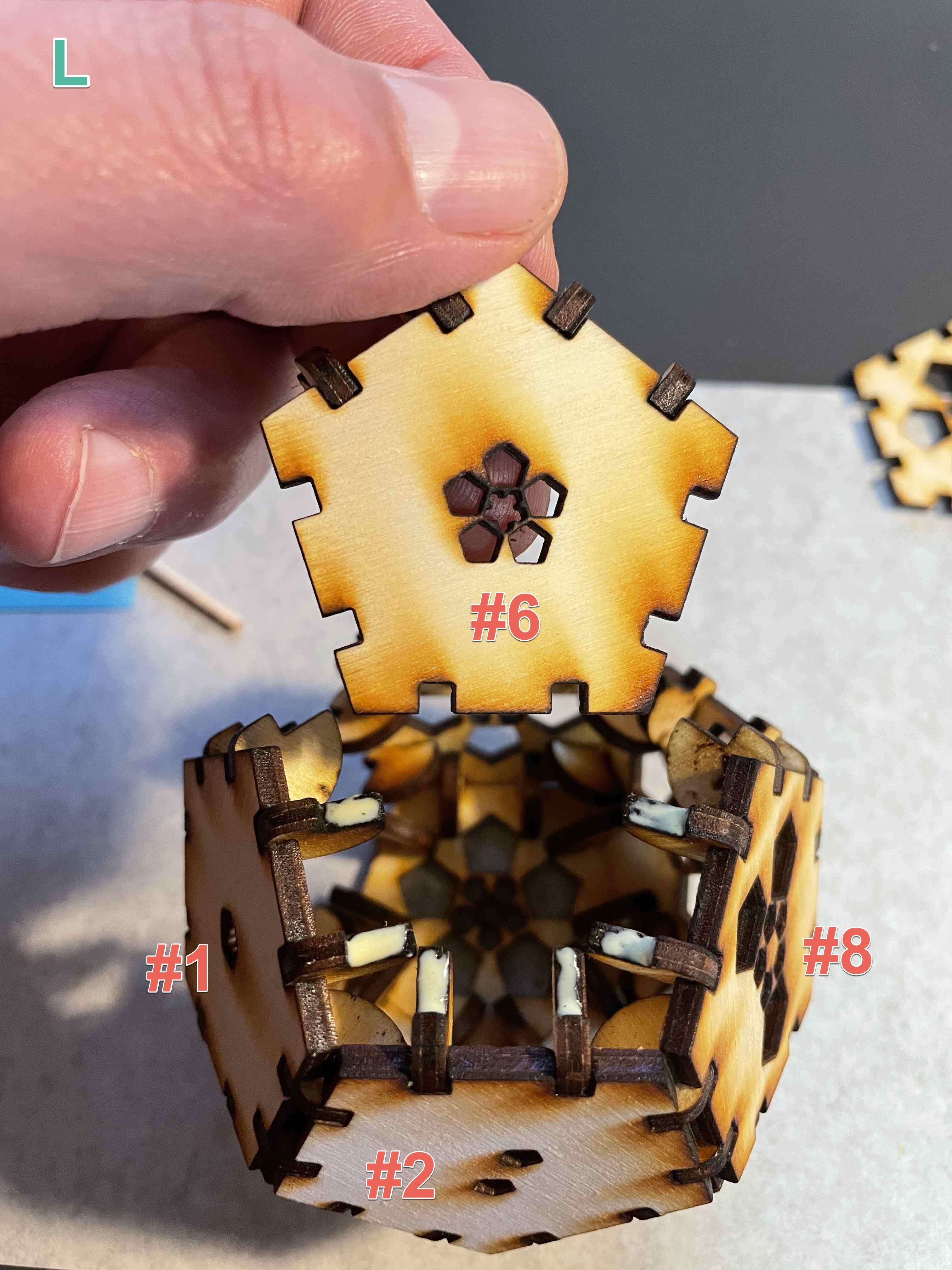
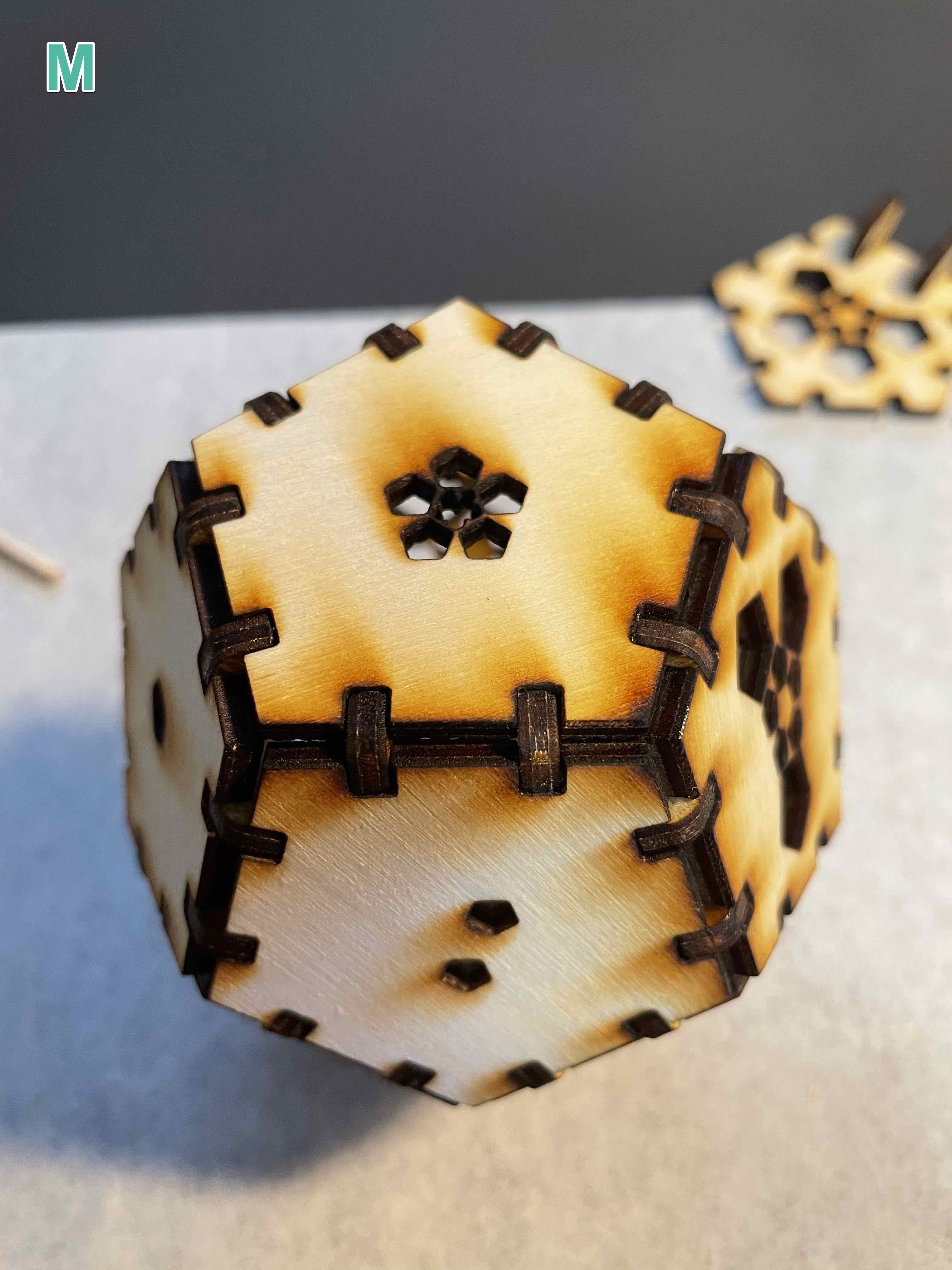
- Select face piece #4 and #9. Glue only 2 joint pieces to one edge as in image N below.
- Tip the polyherdron onto face #8 and rotate so that faces #11 and #3 are in front of you. You will be glueing face #4 between these two pieces and two other pieces, as seen in image O below. Apply glue to the 6 joint pieces. Snap piece #4 into the glued joints so it looks like image P below. You may need to get your fingers inside the poly to slightly bend sides and tweak joints to help it fit.
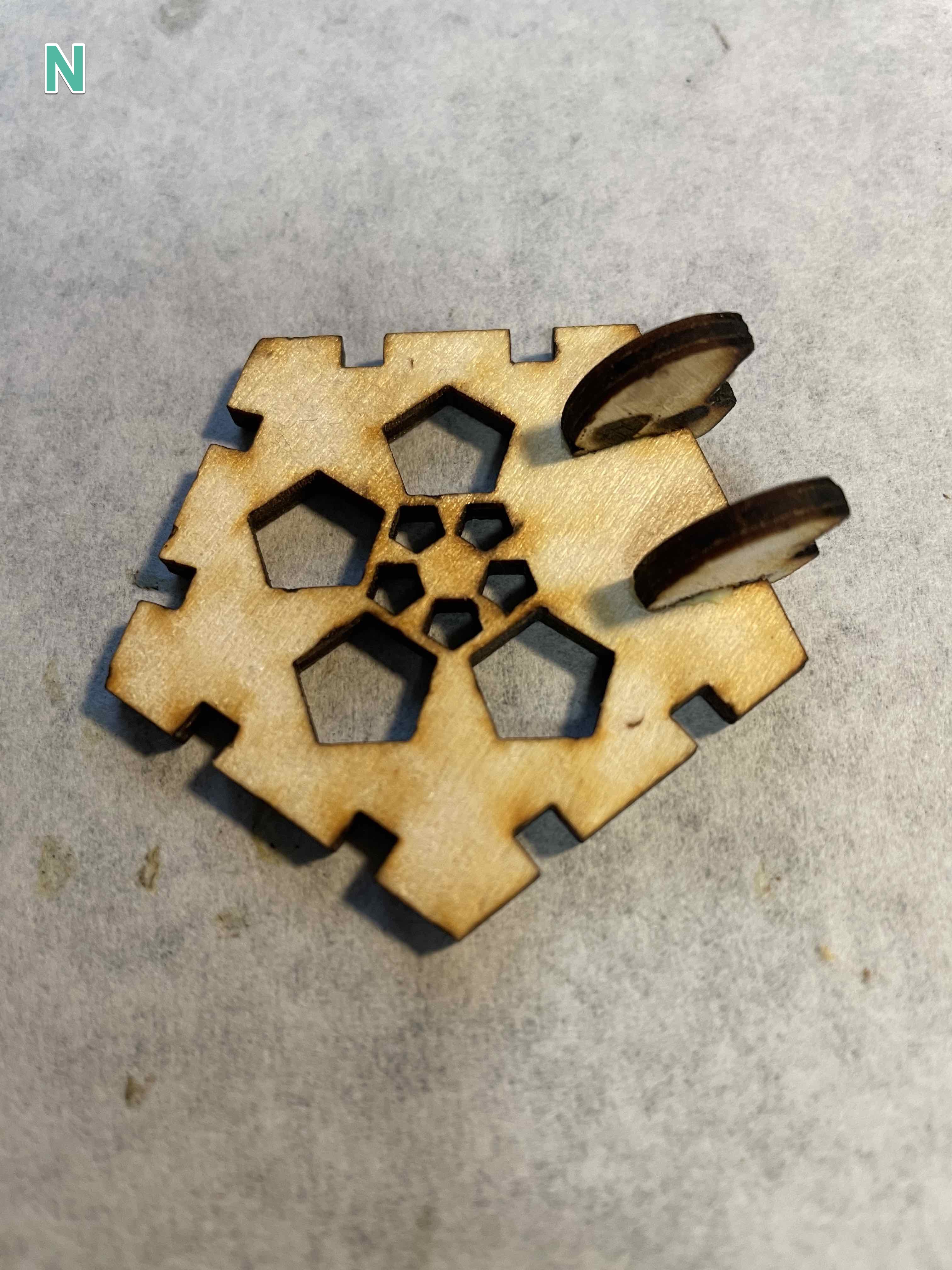
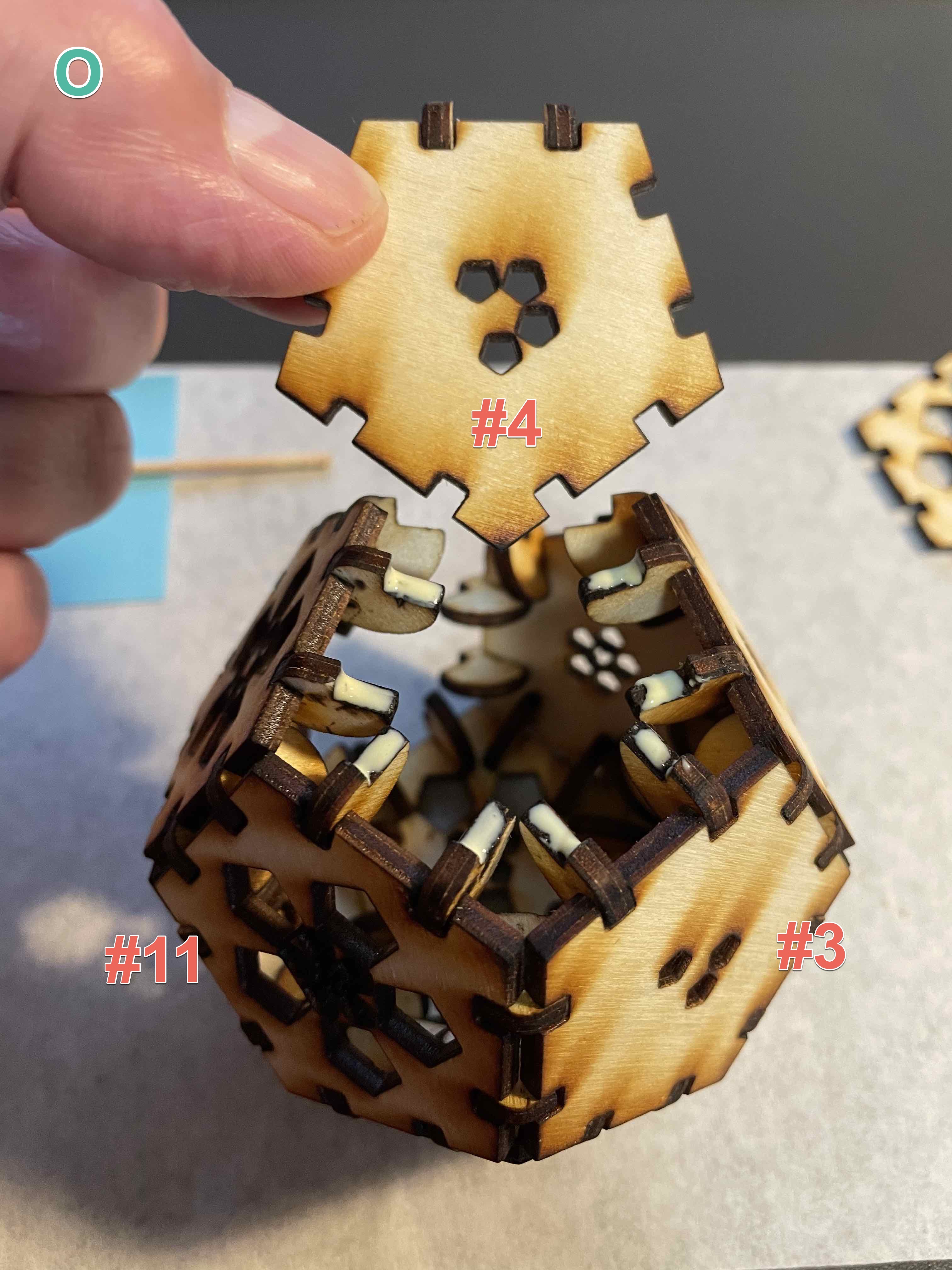
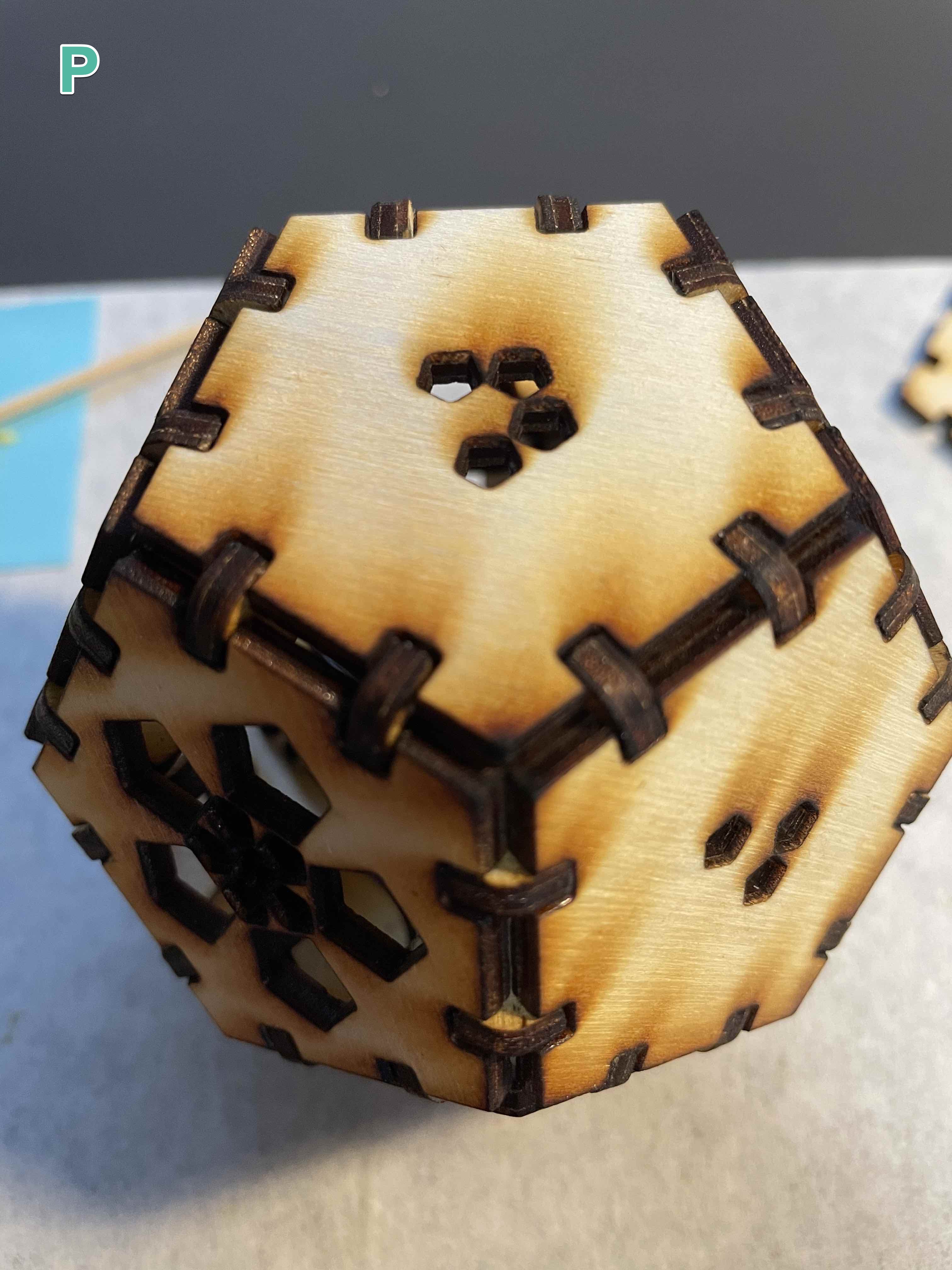
- Tip the polyherdron onto face #3 and rotate so that faces #8 and #7 are in front of you. You will be glueing face #9 between these two pieces and two other pieces, as seen in image Q below. Apply glue to the 6 joint pieces. Snap piece #9 into the glued joints so it looks like image R below. You may need to get your fingers inside the poly to slightly bend sides and tweak joints to help it fit.
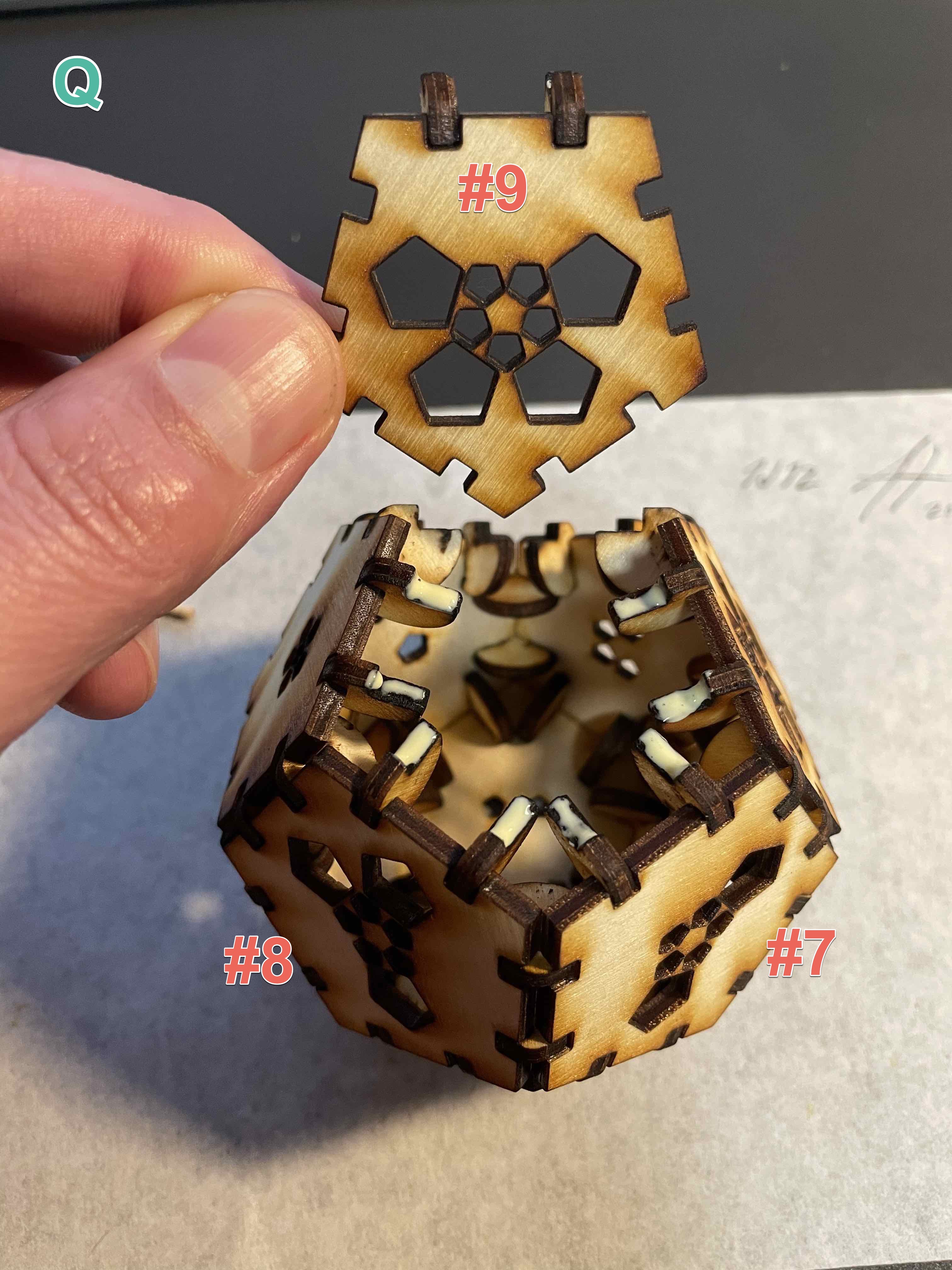
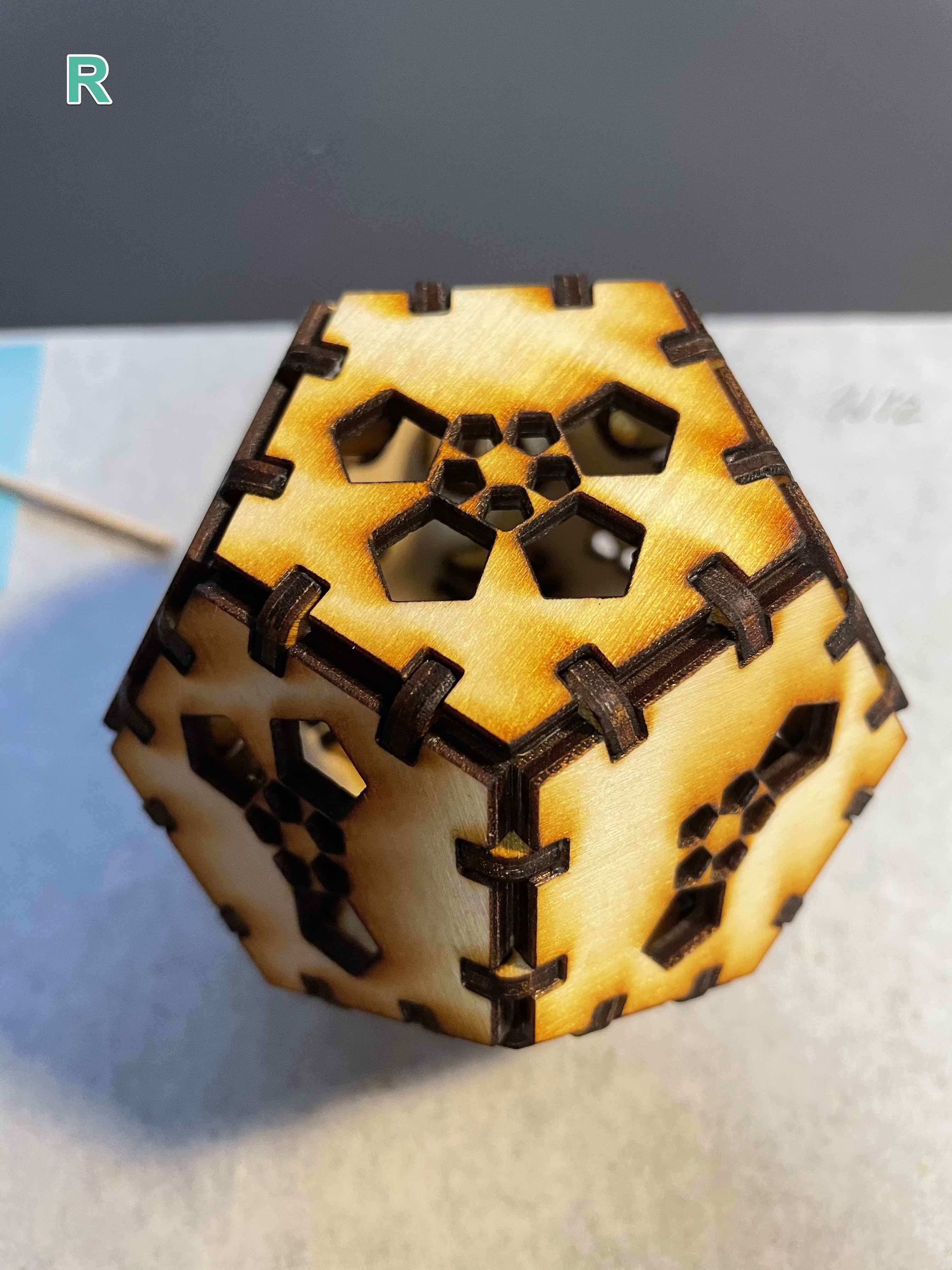
Attaching the Final Piece!
Important Note for Initial Beta Testers:
For those of you with early versions of the D12 poyhedron kit, the final face piece #5 can be hard to squeeze between all of the joints. Using a sharp knife held at a 45° angle to the back of the face, carefully scrape side to side to make a slight slant to the grooves on all edges so that the joints on the poly will more easily slide into place. Make sure not to cut so deep as to affect the front (scorched) side of #5. See #5 Face Piece Adjustments for an image of how to perform this action.- Select face piece #5. This piece should have NO joint pieces attached to it.
- Prior to applying glue to any joints, try a dry fit of the #5 into the polyhedron. If it is too tight, you can either try and gently pry some of the sides out with a narrow tool, or use a knife (see NOTE above) to scrape some wood out of the notches. Make sure you can snap the pice into place before applying any glue.
- Apply glue to the 10 joint pieces as in image S. Snap piece #5 into the glued joints. Use a narrow tool (like a knife or this flathead screwdriver blade) if necessary to gently pry a side out a tiny bit to make it fit. You completed polyhedron should look like image T.
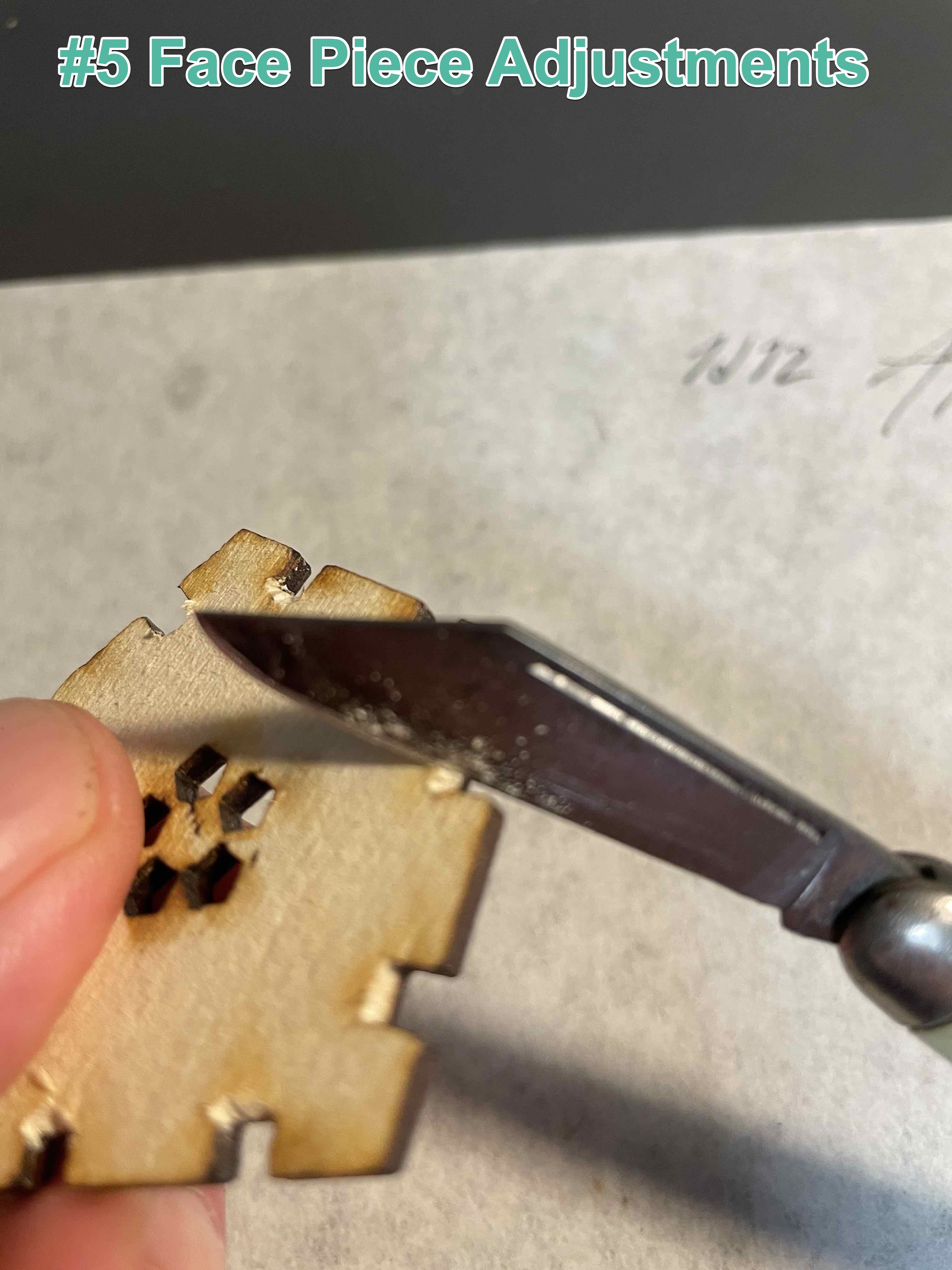
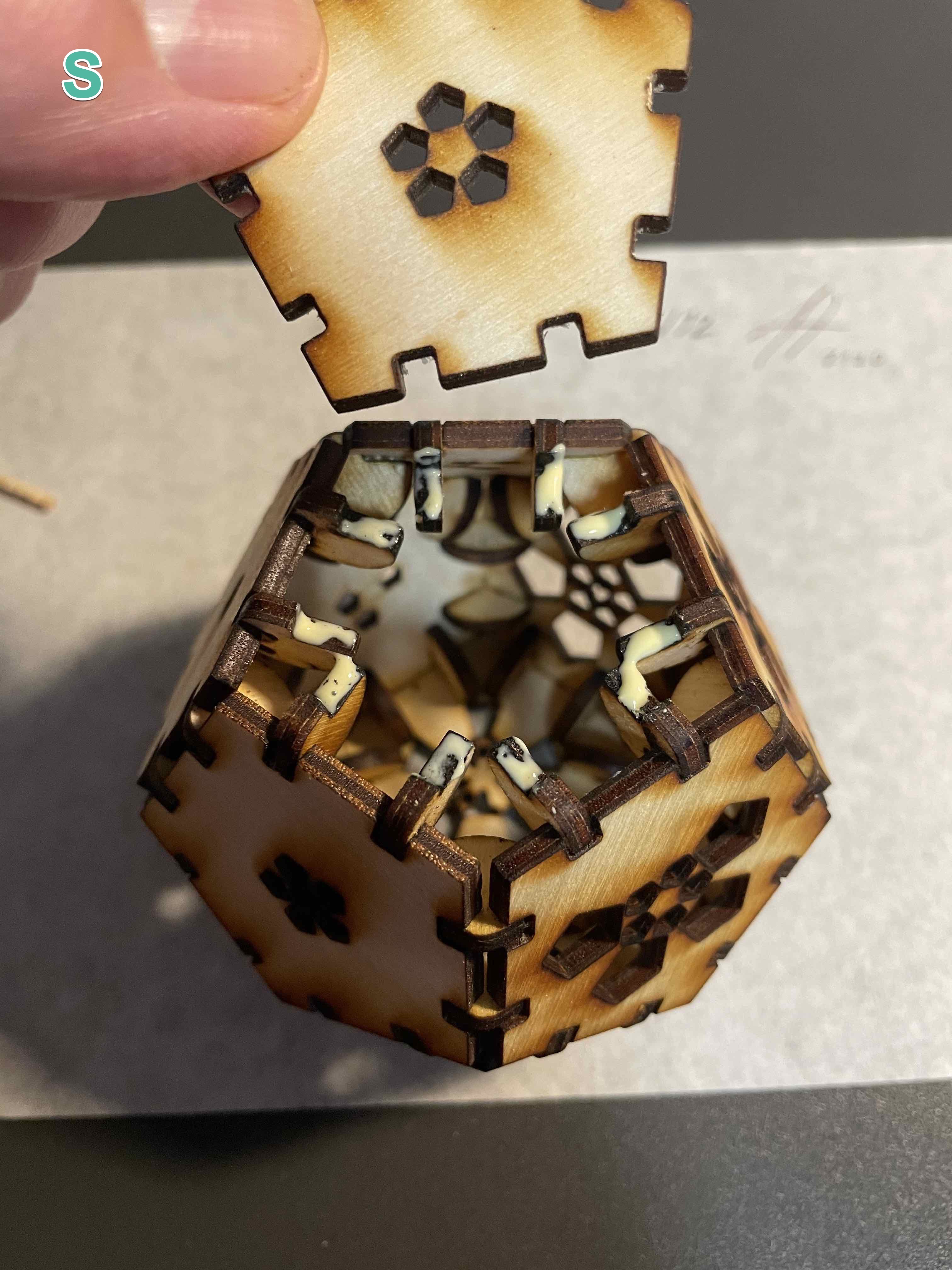
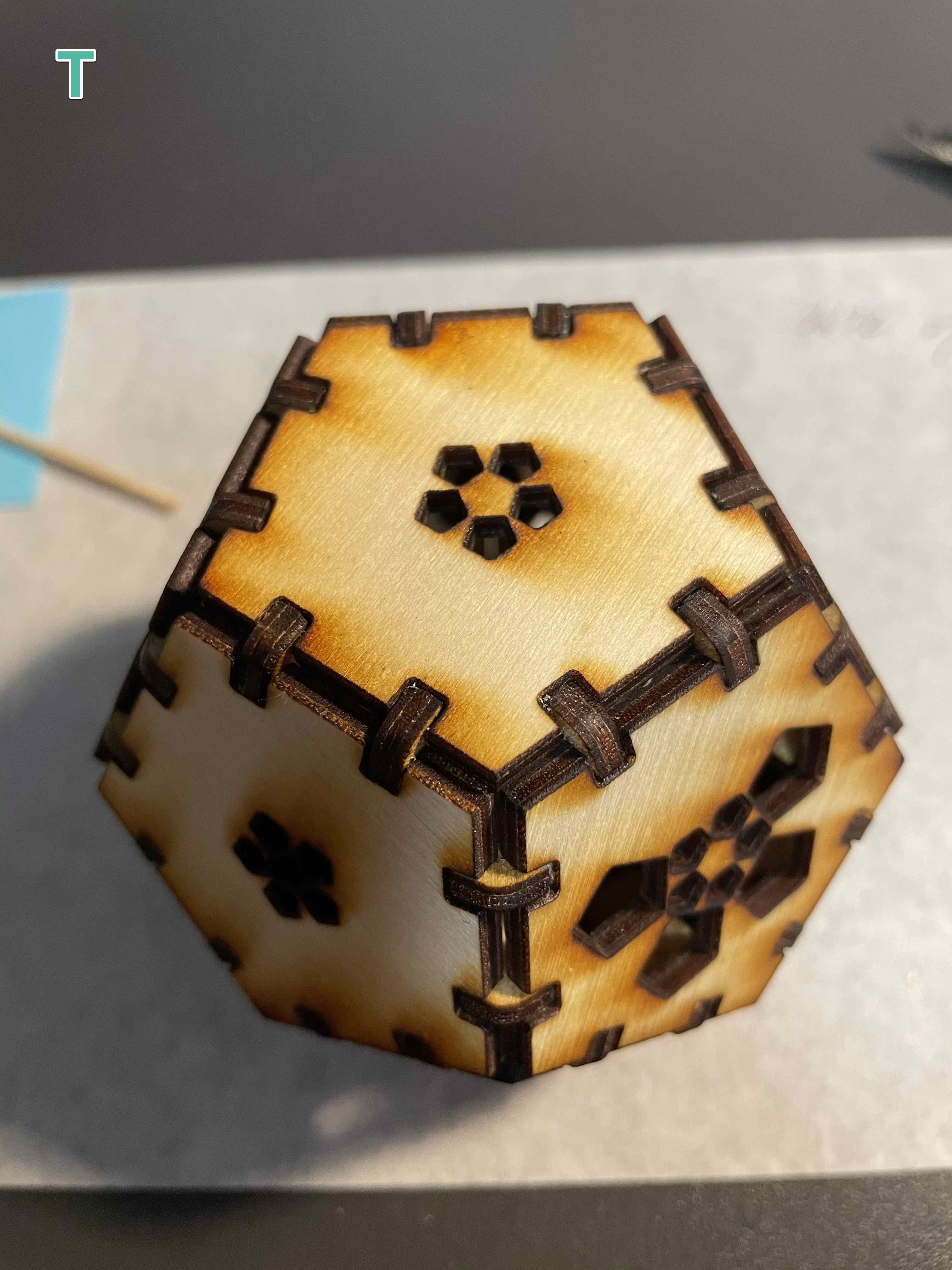
Congratulations! You have a beautiful peice of art!
Now, please take a few minutes to complete out beta tester questionnaire. We really are looking forward to your feedback on completing this kit.